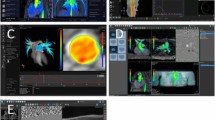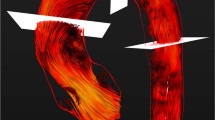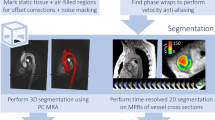Abstract
To test if new software accelerates analysis of in vivo acquired 4D flow MRI data. Respiration-gated and ECG-synchronized 4D flow MRI of the aorta was performed in 20 stroke patients using a routine 3-Tesla MRI system (TIMTRIO, Siemens, Germany). 3D blood flow data was processed by one experienced observer using new (A = MEVISFlow) and widely-used software (B = EnSight + Velomap-/FlowTool). Evaluation included: inter-/intra-observer variability of software A and inter-software comparison regarding (1) blood flow quantification (total-/peak flow) and (2) flow visualisation, plus (3) measurement of the time required for visualization and quantification of data (software A&B). (1) Inter-/intra-observer agreement of software A (mean difference ≤5.2 and ≤0.9 %, respectively) and inter-software agreement (mean difference ≤ 2.2 %) was high with high correlation of peak and total blood flow (r ≥ 0.74; p < 0.001 and r ≥ 0.91; p < 0.001). (2) Comparison of blood flow visualization showed substantial agreement (κ ≥ 0.68). (3) Data-analysis was three times faster when using software A [18:10 (±1:29) vs. 58:30 (±5:28) min; p < 0.0001]. Acceleration of blood flow quantification and visualisation using new software strongly facilitates future applications of 4D flow MRI and thus enables its usage in larger patient cohorts in clinical research and routine.



Similar content being viewed by others
References
Markl M, Wu C, Hurley MC et al (2013) Cerebral arteriovenous malformation: complex 3D hemodynamics and 3D blood flow alterations during staged embolization. J Magn Reson Imaging 38(4):946–950
Schnell S, Ansari SA, Vakil P et al (2014) Three-dimensional hemodynamics in intracranial aneurysms: influence of size and morphology. J Magn Reson Imaging 39(1):120–131
Hope MD, Purcell DD, Hope TA et al (2009) Complete intracranial arterial and venous blood flow evaluation with 4D flow MR imaging. AJNR Am J Neuroradiol 30(2):362–366
Clough RE, Waltham M, Giese D, Taylor PR, Schaeffter T (2012) A new imaging method for assessment of aortic dissection using four-dimensional phase contrast magnetic resonance imaging. J Vasc Surg 4:914–923
Hope T, Markl M, Wigstrom L et al (2007) Comparison of flow patterns in ascending aortic aneurysms and volunteers using four-dimensional magnetic resonance velocity mapping. J Magn Reson Imaging 26(6):1471–1479
Geiger J, Hirtler D, Bürk J et al (2014) Postoperative pulmonary and aortic 3D haemodynamics in patients after repair of transposition of the great arteries. Eur Radiol 24(1):200–208
Von Knobelsdorff-Brenkenhoff F, Trauzeddel RF, Barker AJ et al (2013) Blood flow characteristics in the ascending aorta after aortic valve replacement-a pilot study using 4D-flow MRI. Int J Cardiol 170(3):426–433
Markl M, Arnold R, Hirtler D et al (2009) Three-dimensional flow characteristics in aortic coarctation and poststenotic dilatation. J Comput Assist Tomogr 33(5):776–778
Goubergrits L, Mevert R, Yevtushenko P et al (2013) The impact of MRI-based inflow for the hemodynamic evaluation of aortic coarctation. Ann Biomed Eng 41(12):2575–2587
Frydrychowicz A, Bley TA, Dittrich S et al (2007) Visualization of vascular hemodynamics in a case of a large patent ductus arteriosus using flow sensitive 3D CMR at 3T. J Cardiovasc Magn Reson 9(3):585–587
Fredriksson A, Zajac J, Eriksson J et al (2011) 4-D blood flow in the human right ventricle. Am J Physiol 301(6):H2344–H2350
Stankovic Z, Csatari Z, Deibert P et al (2012) Normal and altered three-dimensional portal venous hemodynamics in patients with liver cirrhosis. Radiology 262(3):862–873
Roldán-Alzate A, Frydrychowicz A, Niespodzany E et al (2013) In vivo validation of 4D flow MRI for assessing the hemodynamics of portal hypertension. J Magn Reson Imaging 37(5):1100–1108
Bächler P, Valverde I, Pinochet N et al (2013) Caval blood flow distribution in patients with Fontan circulation: quantification by using particle traces from 4D flow MR imaging. Radiology 267(1):67–75
Frydrychowicz A, Berger A, Munoz D et al (2011) Interdependencies of aortic arch secondary flow patterns, geometry, and age analysed by 4-dimensional phase contrast magnetic resonance imaging at 3 Tesla. Eur Radiol 22(5):1122–1130
Bogren HG, Buonocore MH, Valente RJ (2004) Four-dimensional magnetic resonance velocity mapping of blood flow patterns in the aorta in patients with atherosclerotic coronary artery disease compared to age-matched normal subjects. J Magn Reson Imaging 19(4):417–427
Harloff A, Simon J, Brendecke S et al (2010) Complex plaques in the proximal descending aorta: an underestimated embolic source of stroke. Stroke 41(6):1145–1150
Mahadevia R, Barker AJ, Schnell S et al (2014) Bicuspid aortic cusp fusion morphology alters aortic three-dimensional outflow patterns, wall shear stress, and expression of aortopathy. Circulation 129(6):673–682
Frydrychowicz A, François CJ, Turski PA (2011) Four-dimensional phase contrast magnetic resonance angiography: potential clinical applications. Eur J Radiol 80(1):24–35
Markl M, Wegent F, Zech T et al (2010) In vivo wall shear stress distribution in the carotid artery: effect of bifurcation geometry, internal carotid artery stenosis, and recanalization therapy. Circ Cardiovasc Imaging 3(6):647–655
Bieging ET, Frydrychowicz A, Wentland A et al (2011) In vivo three-dimensional MR wall shear stress estimation in ascending aortic dilatation. J Magn Reson Imaging 33(3):589–597
Markl M, Wallis W, Harloff A (2011) Reproducibility of flow and wall shear stress analysis using flow-sensitive four-dimensional MRI. J Magn Reson Imaging 33(4):988–994
Drexl JB, Hennemuth A, Meier S et al (2012) A tool for the interactive analysis and exploration of in vivo haemodynamics from 4D PC MRI. J Cardiovasc Magn Reson 14(Suppl 1):W70
Gerard ED. http://www.randomization.com.
Markl M, Harloff A, Bley TA et al (2007) Time-resolved 3D MR velocity mapping at 3T: improved navigator-gated assessment of vascular anatomy and blood flow. J Magn Reson Imaging 25(4):824–831
Hennemuth A, Friman O, Schumann C et al (2011) Fast interactive exploration of 4D MRI flow data. In: Proceedings of medical imaging, SPIE 7964, Lake Buena Vista
Bernstein MA, Zhou XJ, Polzin JA et al (1998) Concomitant gradient terms in phase contrast MR: analysis and correction. Magn Reson Med 39(2):300–308
Walker PG, Cranney GB, Scheidegger MB et al (1993) Semiautomated method for noise reduction and background phase error correction in MR phase velocity data. J Magn Reson Imaging 3(3):521–530
Bland JM, Altman DG (1986) Statistical methods for assessing agreement between two methods of clinical measurement. Lancet 1(8476):307–310
Katsanos H, Giannopoulos S, Kosmidou M et al (2014) Complex atheromatous plaques in the descending aorta and the risk of stroke: a systematic review and meta-analysis. Stroke 45(6):1764–1770
Acknowledgments
The authors thank Leonie Eisebraun, Adriana Komancsek and Hansjörg Mast for performing MRI examinations and Samuel McNicholls for proofreading the final manuscript. Prof. Dr. Andreas Harloff receives funding from Deutsche Forschungsgemeinschaft (DFG) grant #HA5399/3-1. Johann Drexl receives funding from Deutsche Forschungsgemeinschaft (DFG) grant #FR2795/2-1.
Conflict of interest
Prof. Dr. Andreas Harloff has received speaker honoraria by Boehringer-Ingelheim, Bristol-Myers Squibb, Pfizer Pharma GmbH, Bayer Healthcare, Bayer Pharma, Medtronic and Sanofi-Aventis Deutschland GmbH. None of the authors has financial disclosures that are related to the performance or content of this study and to the submission of this paper.
Author information
Authors and Affiliations
Corresponding author
Rights and permissions
About this article
Cite this article
Wehrum, T., Kams, M., Schroeder, L. et al. Accelerated analysis of three-dimensional blood flow of the thoracic aorta in stroke patients. Int J Cardiovasc Imaging 30, 1571–1577 (2014). https://doi.org/10.1007/s10554-014-0511-z
Received:
Accepted:
Published:
Issue Date:
DOI: https://doi.org/10.1007/s10554-014-0511-z




